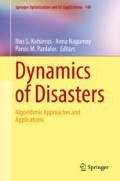Abstract
The oil and gas industry growth has increased rapidly in the Barents Sea during the last few years. The Arctic Zone is considered to be a relatively clean area. However, there is a certain number of “hot spots” in the Arctic due to the activities of extracting companies.
We studied the problems connected with the production of these two types of fossil fuel and carried out simulation model. This model shows the results of oil or gas flowing accident related to drilling complex, taking into account sea currents, winds, temperature, and ice. By using this model, we can highlight areas in the Barents Sea with the highest potential of the disaster so that preventive measures could be taken. In addition, this model helps to organize elimination of fossil fuel flowing consequences.
Access this chapter
Tax calculation will be finalised at checkout
Purchases are for personal use only
References
WWF Report: Oil Spills: Problems Connected with Liquidation of Consequences of Oil Spills in Arctic Seas (in Russian). 2nd edn, augmented (2011)
Hassol, S.: Impacts of a Warming Arctic. Arctic Climate Impact Assessment. AMAP, CAFF, and IASC. Cambridge University Press, New York (2004)
Pavlenko, V.: The environmental standard for the Barents (in Russian). The oil of Russia, No. 4, pp. 71–76 (2012)
Pavlenko, V.I., Muangu, J., Korobov, V.B., Lokhov, A.S.: Actual problems of prevention and liquidation of oil spills in the Arctic and methods of environmental damage to coastal areas assessment (in Russian). Arctic Ecol. Econ. 3(19), 4–11 (2015)
Reed, M., Aamo, O.M., Dling, P.S.: Quantitative analysis of alternate oil spill responce strategies using OSCAR. Spill Sci. Tech. Bull. 2, 67–74 (1995)
Reed, M., Singsaas, I., Daling, P.S., Faksness, L.G., Brakstad, O.G., Hetland, B.A., Hokstad, J.N.: Proceedings of the 2001 Oil Spill Conference. Modeling the Water Accommodated Fraction in OSCAR2000, Tampa, Florida (2001)
Mackay, D., Buist, I., Mascarenhas, R., Paterson, S.: Oil Spill Processes and Models, p. 94. R&D Division, Environmental Protection Service, Ottawa (1980)
Ovsienko, S., Zatsepa, S., Ivchenko, A.: 15th International Conference on Port and Ocean Engineering under Arctic Conditions. Study and Modeling of Behavior and Spreading of Oil in Cold Water and in Ice Conditions, Espoo, Finland (1999)
Ovsienko, S.N., Zatsepa, S.N., Ivchenko, A.A.: Oil Spill Modeling and Environmental Risk Assessment (in Russian). Hydrometeoizdat, No. 209 (2005)
Ovsienko, S.N., Zatsepa, S.N., Ivchenko, A.A.: Numerical Simulation as Data Support Feature for Decision Making when Selecting Strategy for Marine Environment Protection from Oil Pollution (in Russian). Hydrometeoizdat, No. 213 (2011)
Stanovoy, V.V., Lavrenov, I.V., Neelov, I.A: Oil Spill Simulation System for the Arctic Seas. Problems of the Arctic and Antarctic, No. 77 (2007)
Bronson, M., Thompson, E., McAdams, F., McHale, J.: Proceedings 25th Arctic Marine Oil Spill Program Technical Seminar (AMOP). Ice Effects on Barge Based Oil Spill Response Systems in the Alaska Beaufort Sea, Calgary, Alberta, Canada (2002)
Drozdowski, A., Nudds, S., Hannah, C.G., Niu, H., Peterson, I.K., Perrie, W.A.: Review of Oil Spill Trajectory Modelling in the Presence of Ice. Canadian Technical Report of Hydrography and Ocean Sciences (2011)
Westway Expansion Project Oil Spill Modeling, Portland, Oregon (2015)
Zatsepa, S.N., Solbakov, V.V., Stanovoy, V.V.: The experience of creating operational models for calculating the distribution of oil spills in the Barents Sea (in Russian). Arctic Ecol. Econ. 4(16), 68–76 (2014)
Sidnyaev, N.I., Kuzmina, M.S., Metsherin, I.V.: Evaluation of scenarios of oil spills in the offshore zone of the Arctic seas using the models of geological information procession (in Russian). Eng. Surv. 4, 68–80 (2014)
Lesov, V.M: Regional hydrodynamic model of the Hydrometcentre of the Russian Federation (in Russian). 80 years of the Hydrometcentre of the Russian Federation, pp. 36–58 (2010)
Zhilyakova, L.Y.: The application of resource networks for modeling of distribution of substances in the aquatic environment (in Russian), vol. 2, pp. 46–51 (2011)
Aleskerov, F.: Taxation for improving regional ecological situation. Ecological Economics of Sustainability Conference, Washington DC, World Bank (1990)
The Hydrometeorological Research Centre of Russian Federation. http://193.7.160.230/web/esimo/barenc/hfcst/hfcst_barn.php
Acknowledgements
The model was developed within the framework of the Basic Research Program at the National Research University Higher School of Economics (HSE) and supported within the framework of a subsidy by the Russian Academic Excellence Project “5-100”.
We are grateful for the comments and suggests of the anonymous reviewers.
Author information
Authors and Affiliations
Corresponding authors
Editor information
Editors and Affiliations
Rights and permissions
Copyright information
© 2018 Springer Nature Switzerland AG
About this chapter
Cite this chapter
Aleskerov, F., Demin, S. (2018). Modelling Possible Oil Spills in the Barents Sea and their Consequences. In: Kotsireas, I., Nagurney, A., Pardalos, P. (eds) Dynamics of Disasters. DOD 2017. Springer Optimization and Its Applications, vol 140. Springer, Cham. https://doi.org/10.1007/978-3-319-97442-2_2
Download citation
DOI: https://doi.org/10.1007/978-3-319-97442-2_2
Published:
Publisher Name: Springer, Cham
Print ISBN: 978-3-319-97441-5
Online ISBN: 978-3-319-97442-2
eBook Packages: Mathematics and StatisticsMathematics and Statistics (R0)

